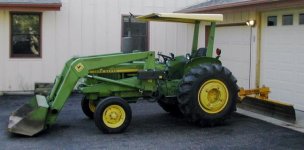bam747
Silver Member
- Joined
- Nov 10, 2004
- Messages
- 200
- Tractor
- John Deere 4720 (2007)
Re: FEL\'s on 2wd tractors
I have a single family owned 1973 John Deere 1020 tractor with a model 48 loader. The tractor is 2WD and is considered a "small utility Ag tractor". They didn't even offer MFWD on this size tractor back then. The tractor is only rated at 38 PTO HP. The model 48 loader is rated at 2,400 lb lift capacity. The tractor has killer power steering on it that never had any problem with even maximum loads in the FEL.
The big difference between the 1020 and today's CUT is that the 1020 is what I call an "old school heavy metal" tractor design. As measured on a certified truck scale, this tractor, loader, cast iron rear wheel ballast weights (330 lbs per side, 660 lbs total), rear 3PH blade (also used for ballast), and ROPS weighs 7500 lbs. This thing is one massive chunk of cast iron from front to back. The front axle is even a solid chunk of cast iron.
In 33 years of use, I have never once lifted a rear tire off the ground with anything the loader would lift. Dirt, gravel, rocks, whatever. And I never had any problems getting the loader to dig into any of the Colorado dirt I tried to dig up with it. Note, however, that the FEL was NEVER used without having the rear blade on for added 3PH ballast.
The other thing about a 1020 versus a modern CUT is that is has a longer wheel base with longer loader arms that put the loader weight further back from the front axle. This gives you a very nicely balanced tractor/FEL setup. To get a better idea of how this tractor and FEL combo looks, see the attachment to this post.
All this being said, if I was buying a new tractor today, be it a CUT or utility Ag tractor, it would definitely have 4WD. No question. But the 4WD would be more for its added traction advantage than loader use.
I think the moral of the story for this 2WD versus 4WD and FEL combination is that with a properly designed and coordinated FEL/tractor combination with proper rear axle AND 3PH ballast, using the FEL on a 2WD tractor can work just fine.
I have a single family owned 1973 John Deere 1020 tractor with a model 48 loader. The tractor is 2WD and is considered a "small utility Ag tractor". They didn't even offer MFWD on this size tractor back then. The tractor is only rated at 38 PTO HP. The model 48 loader is rated at 2,400 lb lift capacity. The tractor has killer power steering on it that never had any problem with even maximum loads in the FEL.
The big difference between the 1020 and today's CUT is that the 1020 is what I call an "old school heavy metal" tractor design. As measured on a certified truck scale, this tractor, loader, cast iron rear wheel ballast weights (330 lbs per side, 660 lbs total), rear 3PH blade (also used for ballast), and ROPS weighs 7500 lbs. This thing is one massive chunk of cast iron from front to back. The front axle is even a solid chunk of cast iron.
In 33 years of use, I have never once lifted a rear tire off the ground with anything the loader would lift. Dirt, gravel, rocks, whatever. And I never had any problems getting the loader to dig into any of the Colorado dirt I tried to dig up with it. Note, however, that the FEL was NEVER used without having the rear blade on for added 3PH ballast.
The other thing about a 1020 versus a modern CUT is that is has a longer wheel base with longer loader arms that put the loader weight further back from the front axle. This gives you a very nicely balanced tractor/FEL setup. To get a better idea of how this tractor and FEL combo looks, see the attachment to this post.
All this being said, if I was buying a new tractor today, be it a CUT or utility Ag tractor, it would definitely have 4WD. No question. But the 4WD would be more for its added traction advantage than loader use.
I think the moral of the story for this 2WD versus 4WD and FEL combination is that with a properly designed and coordinated FEL/tractor combination with proper rear axle AND 3PH ballast, using the FEL on a 2WD tractor can work just fine.

